Collection of materials relating to neuro-ophthalmology as part of the Neuro-Ophthalmology Virtual Education Library.
NOVEL: https://novel.utah.edu/
TO
- NOVEL981
Filters: Collection: "ehsl_novel_novel"
| Title | Creator | Description | Subject | ||
|---|---|---|---|---|---|
| 26 |
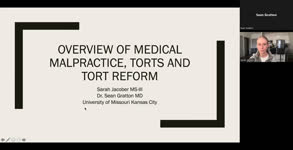 |
Overview of Medical Malpractice, Torts, and Tort Reform | Sarah Jacober; Sean Gratton | This is a brief narrated powerpoint, which serves as an introduction to the basics of medical malpractice. The definition and history of medical malpractice are explored. The relationship between medical malpractice and tort law are explained, and tort reform is introduced. | Lawsuit; Malpractice; Medical Malpractice; Medicolegal; Tort Reform; Torts |
| 27 |
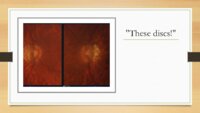 |
Tilted-Disc Syndrome (TDS) - Understanding the Basics | Ahmed Alshaikhsalama; Melanie Truong-Le | This submission is a powerpoint summarizing the literature on a poorly understood disorder known as Tilted Disc Syndrome (TDS). Delving into the fundamental aspects of TDS, this resource meticulously digests complex medical literature to inform readers on the epidemiology, risk factors, complication... | Coloboma; Inferior Crescent; Tilted Disc Syndrome |
| 28 |
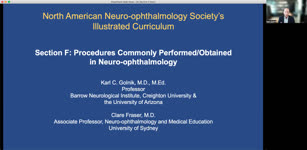 |
NANOS Illustrated Curriculum Section F Introduction | Karl C. Golnik, MD, MEd; Clare Fraser, MD | Introduction video to the resources available in Section F of the NANOS Illustrated Curriculum. | Surgery, Ophthalmic; Surgery, Neurological; Non-surgery procedures; Neurosurgery; Interventional neuroradiology; Neuro-ablation; Neuro-stimulation; Intraocular surgery; Botulinum toxin therapy |
| 29 |
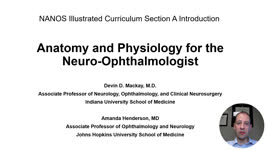 |
NANOS Illustrated Curriculum Section A Introduction | Devin D. Mackay, MD; Amanda D. Henderson, MD | Introduction video to the resources available in Section A of the NANOS Illustrated Curriculum. | Anatomy, Visual Pathways; Anatomy, Eye; Anatomy, Orbit; Anatomy, Intracranial; Anatomy, Orbital Vascular; Cerebrospinal fluid |
| 30 |
 |
The Mystery of Zero Ishihara Plates with 20/20 Vision | Vivian Paraskevi Douglas; Konstantinos Douglas; Nurhan Torun | Herein we present a case of 71-year-old retired teacher who presented with difficulty reading over the past year. On examination, the patient had difficulty identifying even the control plate on Ishihara testing in both eyes (OU), despite intact color recognition. Humphrey visual field testing revea... | Simultanagnosia; Neurodegeneration; Posterior Cortical Atrophy |
| 31 |
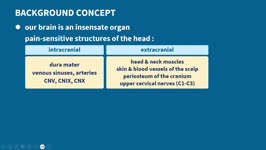 |
Headache Associated With Low or High Intracranial Pressure | Yu Hsin Chen; Amanda Dean Henderson; James Brian Davis | When intracranial pressure changes, the most common symptom is headache, which often has a positional component. We introduce various etiologies of headaches attributed to increased or low intracranial pressure, with idiopathic intracranial hypertension (or primary pseudotumor cerebri), post-dural p... | CSF Leak; Headache; Intracranial Hypertension; Intracranial Hypotension; Papilledema; Pseudotumor Cerebri |
| 32 |
 |
A Case of Left Facial Pain Misdiagnosed as Migraine Headache | Hong Jiang | A 58-year-old female sought a second opinion due to a two-year duration of sporadic left facial pressure pain, along with irritation and dryness in her left eye. She has a well-documented history of episodic migraines characterized by throbbing headaches on the right side. She had been under the car... | Dry Eye; Facial Nerve Schwannoma; Facial Pain |
| 33 |
 |
Trigeminal Autonomic Cephalgias | Kaitlin Keenan; Aimee J. Szewka | These slides are a comprehensive discussion addressing Trigeminal Augonomic Cephalgias - in particular, Cluster Headaches, Paroxysmal Hemicrania, Hemicrania Continua and Short-Lasting Unilateral Neuralgiform Headache Attack (SUNHA). Our slides discuss diagnosis, prognosis and treatment of these rare... | Cluster Headache; Headache; Hemicrania Continua; Paroxysmal Hemicrania; Short-Lasting Unilateral Neuralgiform Headache Attack; Trigeminal Autonomic Cephalgia |
| 34 |
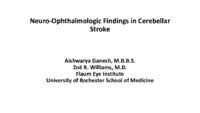 |
Neuro-ophthalmologic Findings in Cerebellar Stroke | Zoe Rebecca Williams; Aishwarya Ganesh | This PowerPoint reviews the anticipated neuro-ophthalmologic findings in cerebellar strokes including posterior inferior cerebellar artery (PICA), anterior inferior cerebellar artery (AICA) and superior cerebellar artery (SCA) territory infarcts. The review includes discussion of potential ocular mi... | AICA; Cerebellar Esotropia; Cerebellar Infarct; Lateral Medullary Syndrome; Nystagmus; Ocular Lateropulsion; PICA; SCA; Skew Deviation |
| 35 |
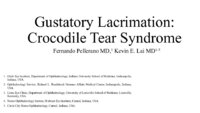 |
Gustatory Lacrimation: Crocodile Tear Syndrome | Fernando Pellerano; Kevin Lai | We describe a case of gustatory lacrimation on a 61-year-old male with a history of Bell's Palsy that presented to the Ophthalmology clinic with painless epiphora in the right eye while eating. Examination was notable for oral-ocular synkinesis and hyperlacrimation while eating on the right eye only... | Crocodile Tear Syndrome; Gustatory Lacrimation; Oral-ocular Synkinesis |
| 36 |
 |
Hydroxychloroquine Retinopathy | Zoe Rebecca Williams, MD; David Allen DiLoreto Jr., MD | This powerpoint reviews hydroxychloroquine retinopathy including the clinical findings and the updated American Academy of Ophthalmology screening guidelines (revised in 2016). It includes images depicting the typical paracentral visual field loss, spectral domain optical coherence tomography findin... | AAO Screening Guidelines; Fundus Autofluorescence; Hydroxychloroquine Retinopathy; Outer Nuclear Layer Loss; Photoreceptor Loss; Retinal Pigment Epithelium Loss; Spectral Domain Optical Coherence Tomography |
| 37 |
 |
Diagnosis and Evaluation of Stroke in the Pons | Padmaja Sudhakar; Fatai Momodu | This short power point describes the anatomy of the pons, followed by description of stroke in the pons along with clinical presentation and work up. | Crossed Signs; One and Half Syndrome; Pontine Stroke |
| 38 |
 |
Financial Social Legal Implications of Genetic Testing | Jonathan Thomas; James Brian Davis | Genetic testing looks for mutations in DNA and can give insight into genetic diseases. Costs associated with genetic testing are the testing itself, as well as genetic counseling. Test results may lead to further considerations, which may impact finances. Genetic test results can have a social impac... | Financial; Genetic Information Nondiscrimination Act of 2008; Genetic Testing; Legal; Social |
| 39 |
 |
Injury Prevention in the Visually Impaired | Jonathan Thomas; James Brian Davis; Amanda Dean Henderson | With an aging population in the US, the number of those with visual impairments is also rising. Visual impairments increase the risk of falls, injuries, and other deficiencies, but there are several potential strategies to prevent these injuries. Members of the healthcare team can help visually impa... | Fall; Injury Prevention; Low Vision Specialist; Visually Impaired |
| 40 |
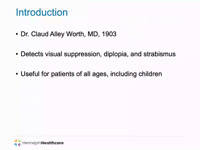 |
Worth 4-Dot Test | Angela Cao; Anne Abel | This presentation describes the Worth 4-Dot test, demonstrates how to perform the test, and interpret results. | Amblyopia; Diplopia; Worth 4-dot Test |
| 41 |
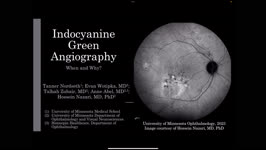 |
Idocyanine Green Angiography | Tanner Nordseth; Evan Wotipka; Talhah Zubair; Anne Abel; Hossein Nazari | This narrated PowerPoint presentation gives an overview of idocyanine green angiography. Historical significance, diagnostic utility, and comparison to fluorescein angiography are discussed. | Angiography; Choroidal imaging; Idocyanine green |
| 42 |
 |
Sixth nerve palsy or not? (Image) | Vivian Paraskevi Douglas; Konstantinos Douglas; Nurhan Torun | Here in we present a case of a 72-yearold Caucasian female with remote history of breast cancer who presented with diplopia in the right gaze over the past several months. There had been no improvement after a 5-day course of steroids by an outside ophthalmologist. On neuro-ophthalmic examination, t... | Abduction deficit; Diplopia; Orbital imaging |
| 43 |
 |
Sixth nerve palsy or not? (Video) | Vivian Paraskevi Douglas; Konstantinos Douglas; Nurhan Torun | Here in we present a case of a 72-yearold Caucasian female with remote history of breast cancer who presented with diplopia in the right gaze over the past several months. There had been no improvement after a 5-day course of steroids by an outside ophthalmologist. On neuro-ophthalmic examination, t... | Abduction deficit; Diplopia; Orbital imaging |
| 44 |
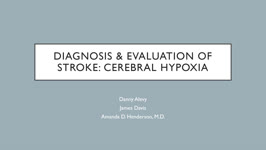 |
Diagnosis and Evaluation of Stroke: Cerebral Hypoxia | Danny Alevy; James Brian Davis; Amanda Dean Henderson | Neurons are particularly vulnerable to oxygen deprivation. Cerebral hypoxia can be caused by arterial thrombosis, embolism, hypoperfusion, cervical artery dissection, or cryptogenic causes. About 1/3 of ischemic strokes are from cryptogenic causes. Embolic strokes are the next most common (20-30%), ... | Atherosclerosis; Cerebral Hypoxia; Cervical Artery Dissection; Cryptogenic Ischemia; Embolism; Hypoperfusion; Ischemia; Stroke; Thrombosis |
| 45 |
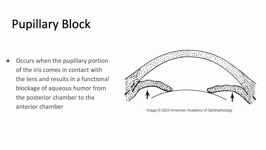 |
Pupillary Block | Sujata Dalal; James Brian Davis; Amanda Dean Henderson | Pupillary block occurs when the pupillary margin of the iris contacts the anterior surface of the lens. This creates a barrier for the outflow of aqueous humor from the posterior chamber to the anterior chamber and resultant increased pressure in the posterior chamber. This pressure can cause the ir... | Angle-Closure Glaucoma; Iris Bombe; Narrow Angle; Pupillary Block |
| 46 |
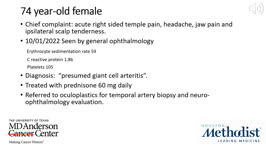 |
Behind the Mask | Pame Dávila; Nagham Al-Zubidi | Case report describing temporal artery amyloidosis masquerading as giant cell arteritis. | Giant cell arteritis; Temporal arteritis; Temporal artery amyloidosis |
| 47 |
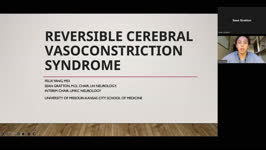 |
Reversible Cerebral Vasoconstriction Syndrome (RCVS) | Felix Yang; Sean Gratton | This is a narrated powerpoint that reviews Reversible Cerebral Vasoconstriction syndrome. It discusses the diagnostic basics and evaluation and management. It compares RCVS to Posterior Reversible Encephalopathy Syndrome (PRES). | Primary Angiitis of the Central Nervous System; Reversible Cerebral Vasoconstriction Syndrome; Subarachnoid Hemorrhage; Thunderclap Headache |
| 48 |
 |
Glaucoma: Evaluation and Principles of Management | Anand Haran; Sean Gratton | This is a narrated powerpoint that reviews the basics of glaucoma. It covers Primary Open Angle Glaucoma and Angle Closure Glaucoma, and includes reviews of the pathophysiology, evaluation, and management | Angle Closure Glaucoma; Glaucoma; Primary Open Angle Glaucoma |
| 49 |
 |
Neuro-Ophthalmic Complications of Chemotherapy | Nagham Al-Zubidi; May Ameri | This lecture covers the effect of antineoplastic chemotherapy, which can cause damage to the optic nerve and the ocular motor nerves. | Antineoplastic Chemotherapy; Ocular Motor Nerve Damage; Optic Atrophy; Optic Nerve Damage; Optic Nerve Edema; Optic Neuritis |
| 50 |
 |
Chorioretinal Coloboma | Kirstyn Taylor; Drew Scoles, MD | Coloboma is a term used to describe defects seen in various ocular structures due to incomplete embryologic development. Fundus coloboma specifically is due to failure of the embryonal fissure to close, which typically occurs by 5-7 weeks gestation. Posterior colobomas, involving the retina, choroid... | Chorioretinal; Coloboma; Optic Nerve |
